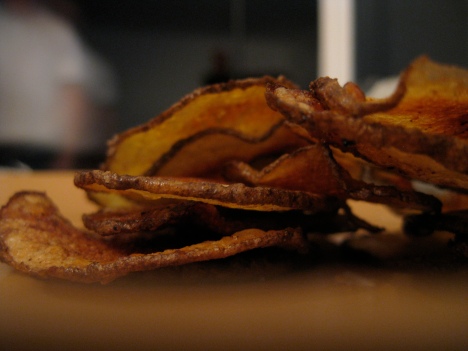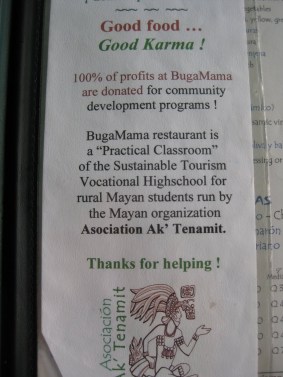
The 15th of September is independence day in Guatemala and all of Central America actually. In 1821 they officially split from Spain. I was particularly thankful for the day because Héc got the entire week off! We took advantage of the time and went on an expedition to the highlands of Las Verapaces — the north central part of the country. I had never been to the region but had been yearning to go since the day I saw a photo of the gorgeous green rolling mountains with cascading waterfalls scattered about.
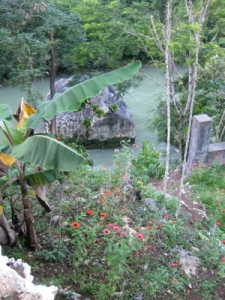
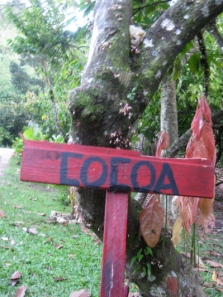
Left: the Cohobón river running past our hostel. Right: A cacao tree around the park, from where they make chocolate. Some locals were selling a crude, homemade chocolate using the cacao pods and sugar crushed together.
——————————————————————————————
The reason we had waited so long to make the trip was because its not an easy to place to reach. The roads in the past have been poorly maintained, the highways curve tightly around the mountains rather than cut through the base as in Colorado. Therefore, a trip that would perhaps take no more than two hours in the midwest takes an hard and bumpy four.
The first destination on our itinerary was Semuc Champey…or a hostel which lies just outside. Semuc Champey is a natural reserve with beautiful aqua-blue lagoons positioned on top of a “stone bridge”, as it is called. The bridge is a rock formation which makes a type of cap over the Cohobón river. It is truly a paradise….but to get there is quite a journey, as it is located in the middle of nowhere. You first must make the windy journey from the capital to Cobán, which lasts about 4 hours. The only problem is that, even if you purchase your seat a head of time, you will be among 20 or 25 people crammed into a 15 passenger van. Personal borders do not exist here. It didn’t seem to matter that we in the van were already uncomfortably full…if someone on the side of the road hailed us down we came a-screeching to a halt, the ayudante (the bus driver’s helper) would toss the new passenger’s baggage carelessly on the roof, then ask everyone to scoot over a bit more. At one point a poor old man had someone else’s grandma sitting on his lap and I half expected to be handed a stranger’s baby to hold for a time.

From Cobán you must take another 2 hour microbus to Lanquin. The bus is usually of the same variety as the previous, packed to the max; but it passes through some of the most gorgeous green country I’ve ever seen, so I completely forgot that my legs were numb. I won’t compare it to Ireland or Switzerland as I have heard do others, but only because I heard a Swiss girl drone on and on about how Switzerland is so much prettier than Guate. To me, it was absolutely breathtaking: rolling hills, strangely pointy mountains, everything covered in a lush-mossy green. The two hours passed in a flash as a gazed out the window…despite the little girl getting car sick just in front of us.

As the sun began to set we arrived in Lanquin, a little pueblo only 12 kilometers or so from Semuc, and where our hostel was located. We relaxed on a stoop outside a tienda and enjoyed a cold beer while waiting for our final transport to arrive. Within a half an hour we were whisked away to our hotel, in the middle of nowhere, and were safely in our little bungalow as the most fierce thunderstorm with a brilliant electric show began. We nestled into our rather hard beds and fell asleep to crashes of thunder and flashes of lightening.


The next day we awoke quite late, inhaled a very salty breakfast from the sparse menu our little rustic lodge offered, and then ventured into the jungle to explore some lagoons and hike some trails! The entrance to Seumuc was only 200 meters from our lodging, but once in the park we hiked an agonizing 1.2 kilometers nearly vertical. (You Amazing-Race trialthelon types are probably rolling your eyes at me…but this was basically rock climbing people. And that’s not my kind of sport!) The goal was the mirador (or viewpoint) where we got a glimpse of the mystical lagoons and rock bridge. Once we arrived at the top e rested for quite some time, relaxing in the shade, talking with Santiago- one of the many “rangers”, and gaining the courage to descend back down. It was slippery on the way up, and I imagined myself bouncing off the cliffs on the way down. It wasn’t as bad as in my mind, although I bit the dust (or mud, rather) a few times.

At the bottom again, we wandered to las pozas (lagoons) where we floated around, protected from the savage heat, for a few hours in the late afternoon. I could have spent an entire week just swimming in the pools…but unfortunately we aren’t children on a summer vacation, nor are we retired like someone I know. (Hint hint…you guys need to check this place out sometime next year!

The next day we visited Las Grutas de Lanquin–a large network of caves located just outside the town of Lanquin. We had to hike a shadeless kilometer to get to the entrance, but once there we spent an hour or so wandering around in the damp caverns, enjoying the shelter from the sun. From the caves we caught a bus back to the city of Cobán. We were exhausted from all the hiking and were looking forward to sleeping in a comfortable hotel, hopefully with cable TV, a luxury we don’t enjoy at home. It took us quite awhile to find such a place. I don’t know if I mentioned before, but Cobán is located in a particularly cloudy region of the country. The guides all say it is sunny for three weeks a year — in April — and the rest of the year a gloomy sheet of clouds sits over the city. We were lucky (or perhaps not) because it was very sunny and sometimes unbearably warm. It did provide for beautiful scenery. However…while walking around in the sunny afternoon, the sky opened up and began to pour down rain while the sun remained. How odd…


We finally found a Hotel within our budget: Monja Blanca. It was a beautiful yet strange place. The property was the traditional colonial style with the rooms along corridors surrounding beautiful courtyards filled with fruit trees and tropical plants. The rooms and hallways were lined with beautiful antique furniture, and little details such as a fresh glass pitcher of pure water in each room, took us back in time. But the joint was vacant. We rang the bell and waited so long we almost left before the doorman answered. He led us through one courtyard and into another. The sun was starting to set, and no lights were lit within the residence, and it was eerily silent. I have to admit that I was creeped out, but the doorman was very cheery, and led us to a cozy room with good ventilation, a clean hot shower, and cable TV 🙂 The price was right, so we stayed. He didn’t ask us for a credit card, a name, nothing. He gave us the key and told us we could settle everything in the morning. Such trust you don’t often find these days.
We took a nap, showered, then went in search for K’akik, the meal Cobán is famous for. K’akik is a traditional Mayan recipe of chunto (wild turkey) in a bath of herbs, veggies, and toasted spices including tomato, chile guaque, cinnamon, cloves, mint, and cilantro. It is traditionally served with the simple, sweet corn tamales wrapped in banana leaves. It was a delicious and filling meal after a hard day of hiking and traveling. I have never made the dish, however I have posted the recipe below. It doesn’t seem too difficult, although it surely takes some time to let the bird stew to a tender texture.
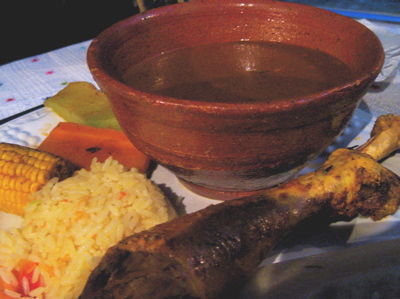
Kakik. Also Cack-ik, Kac-Ik, Caquik. Serves 4-6.
Ingredients:
5 pound wild turkey (or a store bought chicken would work just fine)
One entire bulb of garlic
Two or three sticks of cinnamon
One pound of tomatillos
10 o 15 tomatoes
4 chiles guaques (or spicy dried peppers)
10 cloves
One bunch of cilantro
One bunch of mint
One bunch of green onions (just the greens)
Achiote y sal to taste (I’m not sure if this is easily available in the U.S. Try Mexican grocers, but its ok to skip. It gives the deep red color of the stew, but not much in terms of flavor)
Directions:
1. Place the turkey in a large pot and just cover with water, bring to a boil, then reduce to suimmer. Add the garlic, cinnamon, and cloves. Cook until the turkey is done.
2. Meanwhile, sautee the tomatoes, onions, tomatillos, and chiles. Once they are all tender, puree them. Pass them through a collendar to remove the chunks and leave only a smooth sauce. Add the achiote to some cold water to dissolve it, then add the the mixture.
3. Add the mixture to the cooking bird and simmer for some time on very low heat, until the bird is tender.
4. Traditionally served with rice or simple corn tamales, as well as cooked carrots, squash, potato, and corn on the cob.
Recipe roughly translated from here: http://www.quetzalnet.com/recetas/Cack-ik.html
Filed under: Comida Tipica, Travel | Tagged: Guatemala, Semuc Champey, Soup, Stew, Travel, Turkey | 2 Comments »

















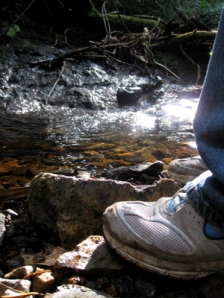


















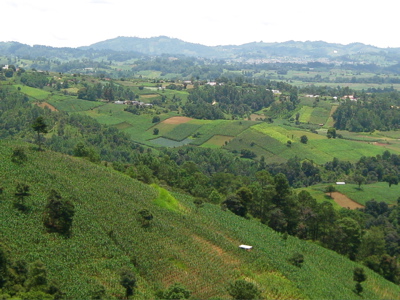
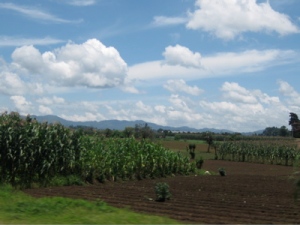 Americas or Boulevard Reforma on a Sunday afternoon, to find a clean green space where one can go with their family for a picnic, one must drive a little ways outside of the city. In addition to green space, clean air and streets are valuable goods. There is lots of littering, and lots of pollution happening around the city. My guess is that the government has bigger problems to worry about at the moment, such as murder, violence, and corruption; funds are diverted elsewhere.
Americas or Boulevard Reforma on a Sunday afternoon, to find a clean green space where one can go with their family for a picnic, one must drive a little ways outside of the city. In addition to green space, clean air and streets are valuable goods. There is lots of littering, and lots of pollution happening around the city. My guess is that the government has bigger problems to worry about at the moment, such as murder, violence, and corruption; funds are diverted elsewhere. On Saturday we took a trip outside the city. We traveled only an hour and a half away — through beautiful farmland and patchwork-adorned rolling hills — to a little pueblo named Tecpán. A little beyond the pueblo is the ancient Mayan city of Iximché (proounced eek-seem-shey) which is now a national reserve. The ruins are not very large, nothing to compare to
On Saturday we took a trip outside the city. We traveled only an hour and a half away — through beautiful farmland and patchwork-adorned rolling hills — to a little pueblo named Tecpán. A little beyond the pueblo is the ancient Mayan city of Iximché (proounced eek-seem-shey) which is now a national reserve. The ruins are not very large, nothing to compare to  We walked around the ruins for a little while before we settled under a tree to just rest and watch. The sun was out, blazing hot, but we were safely sheltered by the tree. We were really lucky to catch a sunny day like this in the middle of the rainy season. We just laid there watching a group of indigenous kids playing a very complex version of tenta electrica for quite some time, enjoying the nature and the tranquility.
We walked around the ruins for a little while before we settled under a tree to just rest and watch. The sun was out, blazing hot, but we were safely sheltered by the tree. We were really lucky to catch a sunny day like this in the middle of the rainy season. We just laid there watching a group of indigenous kids playing a very complex version of tenta electrica for quite some time, enjoying the nature and the tranquility. But then our stomachs began to rumble, and we proceeded to our next destination: lunch! Tecpán is esteemed for its restaurants. There are more than a dozen of them, all advertising carne asada, caldo de gallina criolla (a traditional chicken stew), mantequilla lavada and other fresh dairy products — loads of culinary treats you can’t find as fresh in the city. There are a few restaurants we really like, such as Katok and La Cabaña de Don Robert — but my favorite is Rincón Suizo. I’ve mentioned before that I don’t eat a lot of meat, but when we come to Tecpán I cannot pass up the sausages. I even like the pork chops they serve here, and I don’t ever remembering enjoying pork chops. The meats are top of the line, fresh products from the surrounding countryside. Thats hard to
But then our stomachs began to rumble, and we proceeded to our next destination: lunch! Tecpán is esteemed for its restaurants. There are more than a dozen of them, all advertising carne asada, caldo de gallina criolla (a traditional chicken stew), mantequilla lavada and other fresh dairy products — loads of culinary treats you can’t find as fresh in the city. There are a few restaurants we really like, such as Katok and La Cabaña de Don Robert — but my favorite is Rincón Suizo. I’ve mentioned before that I don’t eat a lot of meat, but when we come to Tecpán I cannot pass up the sausages. I even like the pork chops they serve here, and I don’t ever remembering enjoying pork chops. The meats are top of the line, fresh products from the surrounding countryside. Thats hard to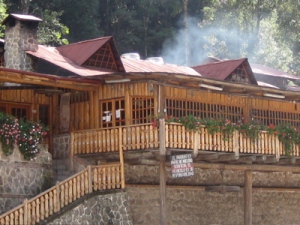 pass up. And the tortillas are made fresh, taken from the komal (cast-iron griddle over a wood-burning fire) seconds before brought to your table. The smell is intoxicating. Here the tortillas are made with yellow corn, versus the white corn tortillas we get in the city. They are different. Not necessarily better, but noticeably different. And because of the freshness, much more enjoyable.
pass up. And the tortillas are made fresh, taken from the komal (cast-iron griddle over a wood-burning fire) seconds before brought to your table. The smell is intoxicating. Here the tortillas are made with yellow corn, versus the white corn tortillas we get in the city. They are different. Not necessarily better, but noticeably different. And because of the freshness, much more enjoyable.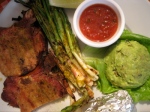 We ordered a typical Guatemalan lunch. Héc had pork chops with roasted cebollines in chimichurrie (green onions in a garlic-parsley-parmesean sauce) and Guacamol. I had chorizo and tortillas with guacamol on the side. We also ordered a portion of aged
We ordered a typical Guatemalan lunch. Héc had pork chops with roasted cebollines in chimichurrie (green onions in a garlic-parsley-parmesean sauce) and Guacamol. I had chorizo and tortillas with guacamol on the side. We also ordered a portion of aged 
